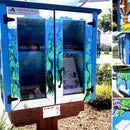Introduction: Yellow Citrine Faux Gemstone Points & Pendants
Citrine is a beautiful yellow quartz crystal often used to make jewelry. The most coveted citrine is lemon yellow with excellent clarity. These clear yellow gems are the most expensive citrine stones, but we can easily reproduce them in resin.
In this tutorial I'll show you how to create realistic citrine gemstone points, and turn them into gorgeous pendants.
Step 1: What You Need
Resin of your choice (clear) - I'm using polyester resin for this project
Mixing cups, stirrers, gloves
Respirator mask
Yellow transparent alcohol dye
Gemstone molds
Gemstone point mold
Piece of parchment or wax paper
Newspaper, mat, or other surface protector
Great ventilation - I'm working outside
Jewelry findings - 2-3" headpins, beads caps, jump rings
Round nose pliers, Flat nose pliers
Step 2: Begin
Take out all your resin supplies and set them up so you don't have to find things with sticky hands. Pour about an ounce of resin into a mixing cup. If you're using polyester resin do NOT add the hardener yet. If you're using epoxy resin, mix a half ounce of each part for 1 ounce total. Only use UV resin if your molds are perfectly clear.
Step 3: Color
Different brands of alcohol dye have different concentrations, so start by adding only one drop of yellow dye to your resin. If it barely shows add another drop or two, once you see a light yellow tint, mix gently and thoroughly.
Step 4: Adjust Color
Keep adding 1-2 drops of dye at a time, and then stir again, until you reach a bright, light yellow. The exact tint is up to you - citrine comes in gradations from barely yellow to and darker, almost orange hue.
Pro Tip:
When you're getting close to the desired color, bring it into a different light. I was working in the shade, so I brought it into the sun to check the color.
Step 5: Hardener
If you're using polyester resin, now is the time to add a drop or two of hardener. (The more drops, the faster it cures.)
Step 6: Mold
Carefully pour the resin into your point mold. Make sure it gets all the way to the bottom without bubbles. If you do see a bubble or air pocket, poke it with a toothpick.
Step 7: Keep Molding
Pour resin into the rest of your point and gemstone molds. Set the molds on a flat surface.
If you have any resin leftover, pour it onto a piece of wax or parchment paper. This is so you can see how your resin is curing without disturbing your molds.
Occasionally test the thickness of the resin with the head part of a head pin.
Step 8: Wait
Step 9: Testing, Testing
Test the resin with a headpin occasionally until the resin has a jelly-like consistency. The headpin should be able to dent the resin before poking through.
When the resin reaches this stage, gently poke through the top of the point mold resin and insert the headpin about 1/4-1/2". If the resin is the right consistency, the pin will remain straight up and be permanently attached to the resin.
Repeat with all of your vertical molds.
Step 10: Wait Again
Leave undisturbed to cure the rest of the way.
You can use your extra resin to continue testing for hardness.
Step 11: Unmold
The "gemstones" will pop out easily.
The points will require some gentle coaxing. You can use the headpin to help pull the cured resin out of the vertical molds.
Step 12: Make a Pendant
Since the head pin is permanently attached, you can string any kind of bead caps and beads onto the wire for adornment. I used a filigree bead cone on my point, and a bead cap and beads on the cylinder. The bead cone was made from a thin metal, so I was able to bend it to fit the point.
When choosing the right findings, see if there's anything you need to hide, like the headpin.
Step 13: Secure Findings
To secure the caps, cones, and beads, you'll make a wrapped loop right above the top finding on each pendant as shown. (See step 6 in this earring Instructable for detailed wrapped loop instructions.)
Wrap the wire tail around the top of the cone or top bead. This will hold everything in place, but if you want extra security, you can add a drop of E6000 or other jewelry glue.
Step 14: Finish Pendant
Add a jump ring to each wrapped loop. Now your faux citrine pendant is ready for a chain!
Step 15: Enjoy!
These faux citrine points lend themselves to lots of possibilities:
You can either get the classic point molds or a variety of other shapes. You can use any assortment of findings or get creative and make your own. You can even experiment with using other materials for your cap like aluminum foil or fabric. Or forget about the caps altogether and just make a simple loop for hanging.
Have fun and let me know how it goes if you try this project!

Participated in the
Colors of the Rainbow Contest













